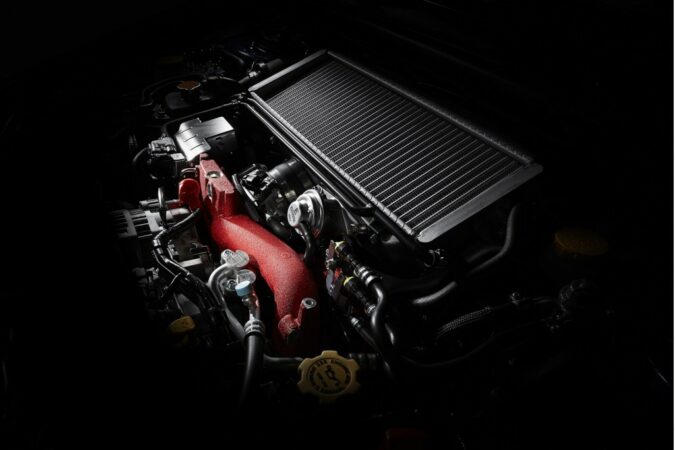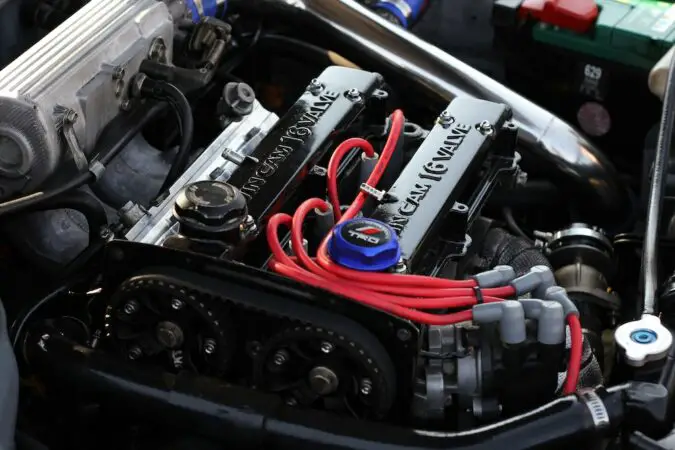Are you experiencing some weird noises coming from the timing belt cover? If this is the case and you ended up in this situation, then you are at the right place because there will be quite a lot to cover when it comes to the timing belt tensioner and its symptoms.
Having a problem like this can be a really frustrating thing to deal with. Namely, because this is one of the problems that you probably don’t want to have. Since engine timing is like a time bomb. A little bit off and everything goes to waste. So, addressing this problem as soon as possible should be your utmost priority.
Luckily for you, when the timing belt starts to fail there are some symptoms that show up and can help you connect the dots in your head and conclude that it is coming from the belt itself or the timing belt tensioner pulley. Which we are going to discuss in this article and learn more about it. And you need to get really well educated to tackle this problem. But we are going to help you out.
First, we will cover the basics of interference engines. Then we will cover the timing belt tensioner and its main two types. Later, we are going to discuss the causes for the timing belt tensioner failure and the symptoms of a bad timing belt tensioner. We will also cover the diagnosing process and costs involved in this work. So, if you want to learn more, follow along.
Understanding Interference Engines And Engine Timing
Now before we cover the timing belt tensioner, let’s learn more about interference and non-interference engines. Knowing this is quite handy for beginners to understand the importance of the timing belt and its main purpose.
So, what is an interference engine in general? An interference engine is a type of engine where the camshaft or camshafts are located on top of the engine head. They are also known as OHC or overhead camshaft engines.
These engines are very different from the non-interference engines which have the camshaft located in the center of the block right on top of the crankshaft. But what do interference and non-interference mean in this case?
It means that on these engines the valve is extending to a position to which the piston is traveling. So, the timing here is key. If you have bad timing the valves and pistons will collide and cause damage.
That’s why the timing belt and timing belt tensioner are there. To maintain the right timing so nothing gets damaged inside of the engine.
That’s why installing these timing belts can be quite tricky because you just don’t know you are going to pull it off if you are inexperienced.
In the shops, usually, these jobs are done by the most experienced mechanics who know what they are doing. If you mess up the timing for even a quarter of an inch, engine damage is imminent.
In the best case, you will replace a few valves. But in the worst case, there will be damage to the cylinder walls and engine head. And that is an expensive business. But now let’s discuss the timing belt tensioner.
What Is A Timing Belt Tensioner?
So, what is a timing belt tensioner? This is important to understand when it comes to this problem and learning how to distinguish a tensioner from a pulley let’s say. They can be quite confusing for beginners that are not into car stuff and cannot locate the timing belt tensioner. So, let’s elaborate on this.
The tensioner is a pulley-like device that is installed on the engine block. This device has a specific role to play and that is to keep the tension on the timing belt.
As you know timing belts, timing chains are not a tight fit, and installing and removing them would have been a real pain to do if there are no tensioners out there. On the timing chain, the tensioner is a plastic device. That is screwed to a point until it delivers a proper tension.
But in timing belt vehicles, the timing belt tensioner is a pulley-like device that we mentioned above. This means that visually it resembles a pulley. The overall design is quite different from a regular pulley. What is different with the tensioner is that it gives the person that is installing it to adjust the tension in the right manner.
So, in order for us to further understand the difference between the pulley and the tensioner, we need to cover the types of timing belt tensioners that are out there. And that’s what we are going to cover in the following chapters.
Types Of Tensioners
We learned what is an interference engine and what is a timing belt tensioner. Now let’s discuss what types of timing belt tensioners are out there.
As you know, there is not only one type of tensioner but two of them. And in the following chapters, we are going to elaborate on them in depth where we will learn their main characteristics.
Hydraulic
The first type of timing belt tensioner that we are going to cover and that less common these days is the hydraulic type of tensioner.
This tensioner is working with the help of hydraulic fluid. The assembly consists of a tensioner pulley, a lever, and a hydraulic actuator. The hydraulic actuator is doing all the magic when it comes to keeping the tension on the belt.
Meaning that the hydraulic actuator inside has a spring and a cylinder as well as hydraulic fluid. When the timing belt tensioner is tightened, the spring is pressed and the proper tension is maintained.
These hydraulic timing belt tensioners are less common these days. But there are also other types of timing tensioners that are more widely used and we are going to cover them next.
Mechanical
This type of timing belt tensioner is the mechanical type. Mechanical means that there is no hydraulic fluid and all that complexity that a hydraulic tensioner has.
This makes the mechanical timing belt tensioners a lot more affordable and cheaper to replace. This design is also known as the “traditional design”. But how this design is put into practice? How does it work under the hood?
The answer is quite simple to explain. All this is done with the help of the spring that is loaded.
Before you jump into replacing your timing belt tensioner, you need to make sure of what type of timing belt tensioner your car is running. But these often come in separate kits with the belt. So, no worries. But have you asked what are the causes for a bad timing belt tensioner? Well, that’s what we are going to cover next.
Causes For Bad Timing Belt Tensioner
Now let’s cover the causes for a bad timing belt tensioner. Knowing the causes will help you out immensely when determining what has caused the failure of your timing belt tensioner.
Because everything happens for a reason, and so do the timing belt and timing belt tensioner failures. And frankly, you don’t want any of these components to fail in the first place. Now let’s elaborate on the causes for this timing belt tensioner failure.
1. Low-Quality Materials
The prime reason for the failure of this component is the use of low-quality materials by the manufacturer of the kit.
Whenever you go out there to purchase a timing belt kit you need to find one that has many positive reviews that will almost guarantee that you get a quality part.
Don’t go for no-name brands. They might be cheaper. But in the long run, are not that reliable. And with something delicate like the timing belt and tensioner you just don’t want to mess up with.
If it fails, it will certainly cause damage inside of the engine. A loose belt is not something you really want. So, pay attention to where and from what brand you purchase the timing belt tensioner. Also, the year of production is quite important.
The belt as well as the tensioner has some rubber components that could dry out after certain years and basically, you will install an expired component on your car. That’s why open your eyes before the purchase of a timing belt tensioner and belt.
2. Service Overdue
Another common cause for the failure of the timing belt tensioner is the overdue service of the timing belt and the tensioner and idler pulleys.
This set needs to be replaced every 60,000 miles or so. If you delay this service and you extend it to 100,000 miles if the belt is good, the tensioner could fail. So, it’s not always up to the belt, the tensioner can also cause problems.
As we said above, get a good kit from a reputable brand and replace it as soon as possible. Especially if you bought a new vehicle and you don’t know when the timing belt tensioner was replaced. Now let’s move on to the following cause.
3. Broken Tension Spring
A tension spring can also be one of the causes for the timing belt tensioner to fail. Why is this the case?
Well, the tensioner is installed before who knows how many miles ago and the spring that is inside of the tensioner tends to stretch and eventually break.
When there is a mild stretch you will start to experience noises or belt snaps. But when it breaks, the whole timing assembly will get loose and the belt will fall off. So, beware of these symptoms of a bad timing belt tensioner. And we are going to elaborate on them later on in this article. Now let’s discuss the last probable cause for the failure of the tensioner.
4. Hydraulic Fluid Leaks
And the last cause of a bad timing belt tensioner that we are going to cover is the hydraulic fluid leaks that develop on the timing belt tensioner. This is a problem that affects only the hydraulic type of belt tensioners.
They have hydraulic fluid inside of them and this fluid can leak and develop some of the symptoms that we are going to cover next in the article.
What to note is that these leaks are serious but not like when a spring breaks down on the mechanical tensioners. Now, let’s move on to the symptoms of a bad timing tensioner.
Timing Belt Tensioner Symptoms
We have covered the causes of why the tensioner fails. Now let’s discuss the symptoms when this component is starting to give up.
Knowing these symptoms is quite essential to detect the problem and diagnose it on time. After learning them you will be able either to tighten the tensioner or to replace it if it’s faulty. So, beware of them if you don’t want to have some permanent engine damage. Now let’s elaborate on the symptoms of a bad tensioner.
1. Squealing Or Rattling Noises
The first thing to pay attention to when there is a bad timing belt tensioner is the squealing or rattling noises that are created whenever there is a problem with the tensioner.
These noises are most common when the engine is cold but as it starts to warm up they will smoothen up. Still, they are very annoying and are a clear indication that there is either a bad idler pulley or a bad tensioner. It is up to you to diagnose the problem before the belt snaps or falls off. Now let’s move to the next timing belt tensioner symptom.
2. Belt Slapping Or Knocking
Another very common symptom of a bad timing belt tensioner is when the belt starts slapping or knocking on the timing cover.
This is the situation when the belt becomes too loose and there is a lot of play in it. So, it knows to jump a few teeth and lose timing along with these noises.
Whenever you notice that something weird is happening underneath the cover, it is high time to give it a check and inspect for possible damaged timing belt tensioner or bad timing belt.
3. Leaks From The Tensioner
On a hydraulic timing belt tensioner, it is also quite common leaks to be spotted. These leaks are right where the tensioner is located and you basically cannot miss them.
This is proof that the hydraulic fluid that was inside of the tensioner has leaked out and is causing you trouble. Or will start to cause trouble in the near future.
So, pop up the timing cover and check the belt condition and see if the tensioner is in good condition. If it’s leaking then you have found your culprit. The tensioner needs replacing as soon as possible if you want to avoid possible damage to your engine.
4. Check Engine Light
A check engine light is also a common symptom whenever there is a bad timing belt tensioner. But why is this the case?
Well, this is the case because the tensioner is keeping tension on the belt. And if it’s loose, the valves can get out of sync.
This will greatly affect the engine performance and the check engine light will illuminate. Then you will have to take things further and deeper investigate this problem in order to determine what really is the cause for this check engine light and that is done with a proper diagnosing tool called an OBD2 scanner. But more on that in a bit when we will cover the diagnosing process. Now let’s cover the last symptom of a bad timing belt tensioner.
5. Misfires
Engine misfires are also present whenever there is a bad timing belt tensioner. So, why is this the case?
Well, this is the case, mostly because the timing belt is loose and the valves are out of sync. Meaning that the timing is off by a small bit. So, whenever you notice a check engine light, you will also experience misfires as well.
Since the timing is off on all of the cylinders. All of them will misfire. That’s how you tell if you have a timing issue. If one cylinder is misfiring then it means that there is something wrong with that specific valve. But if all are misfiring, means that the timing is off. So, in this case, you might want to inspect the tensioner and see if it’s good or not. And in the following chapter, we are going to cover precisely that.
How To Diagnose & Replace A Bad Timing Belt Tensioner?
Now let’s focus on the diagnosing process of a bad timing belt tensioner. This is quite an important thing to do since diagnosing will basically save your engine from possible permanent and irreparable damage done to it.
In order to do this, you will need to learn how to read the symptoms. More precisely to learn how to detect misfires and bad engine timing. Misfires are a big trigger that indicates a problem with the timing. Especially if they are across all of the cylinders. For this, you will need an OBD2 scanner to read the codes and determine from where these misfires are coming from.
Another thing is belt noises that are quite common. Squealing noises especially on startup. But to diagnose the issue 100%, you will have to see what is going on under the timing cover.
There you will see what really is going on and if the belt has tension to it. If the belt is loose and has a lot of play, then the tensioner is probably out.
You can try to tighten it out and see if it works. Also check for leaks, as you can see up in the video the tensioner was leaking. If it’s a mechanical tensioner the spring will break. It depends a lot on the design.
If the belt doesn’t want to tighten, then you have a bad timing belt tensioner and the only thing you can do is to replace it with a new one.
And replacing it can be quite tricky. I would not recommend this work to beginners who don’t know what they are doing because if you mess up the timing the engine could get destroyed. So, beware of this. The best would be to take it to a shop and pay for this.
Cost To Replace A Bad Timing Belt Tensioner?
Now let’s discuss the cost of replacing your timing belt tensioner. And frankly, the cost is not that expensive after all.
If you are looking to replace only the tensioner you can expect to pay about 50$ to $100 for the part if it’s a mechanical tensioner. If the tensioner is hydraulic like in many Honda models you can expect to pay even up to $150 to $200 for the part alone. Which is quite a lot. So, beware if you have a hydraulic tensioner, the cost will be higher.
The labor will also cost between $100 and $200. Depending much on how difficult is to get to the tensioner itself.
But when it comes to this work, your best bet would be to replace the timing belt along with the tensioner. Since you don’t want to do this work twice. If the belt was replaced 30,000 miles ago and is older than 3 years then it is a no-brainer to replace the belt as well.
This will be more costly and could cost you between $500 and $1,050. But the end result will be amazing, you will be good to go for another 60,000 to 80,000 miles with no bad timing belt tensioner problems.
Drive Belt Tensioner Facts:
- A drive belt tensioner is a pulley used to keep tension on the engine belts and drive the engine accessories.
- Spring tensioners automatically tension while pivot design types can be adjusted manually.
- Bad or failing tensioner produces symptoms that can alert drivers of a potential problem.
- Common signs of a bad or failing tensioner include grinding or squeaking noises from the belt, unusual belt wear, and belt-driven accessories failing.
- Loose tensioners can cause the belts to squeak or squeal, especially when the engine is first started.
- A bad pulley can cause fraying on the edges of the belt and, in severe cases, can cause it to break.
- A seized or loose drive belt tensioner can cause the belt to snap, disabling belt-driven accessories and causing problems like overheating, dead electrical system and battery, or disabled AC system.
- A belt that has failed because of the tensioner usually requires replacement of both the belt and tensioner to restore full functionality to the vehicle.
- It is important to have a drive belt tensioner inspected by a professional technician if there are any suspicions of a potential issue.
Conclusion To Timing Belt Tensioner
In this article, we have covered quite a bit when it comes to the timing belt tensioner. First, we learned what is an interference engine and what this tensioner is all about. We covered the types and the role it plays in the internal combustion engine and that is to keep tension on the timing belt so the timing of the engine is always perfect.
After this, we covered the causes why this tensioner is failing and frankly there are a few of them. Namely, poor quality materials, factory defects, and a lot of miles on it. Then we covered the symptoms of a bad tensioner and we learned that the misfires and check engine light are some of them.
Lastly, we learned how to diagnose the problem and the costs involved in replacing this component which is not a lot actually. It will cost you on average about $200 for everything.





